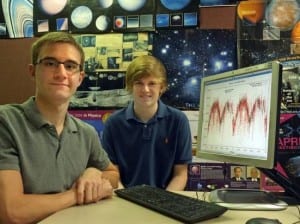Their five stars will be known by 16-digit serial numbers. Dominik would have rather immortalized his four dogs.

Reporter Courtney Collins with the news team at public radio station KERA covered the discovery of five stars made by two Dallas high school students as members of an SMU summer physics research program. Called Quarknet, the program enabled the students to analyze data gleaned from a high-powered telescope in the New Mexico desert.
All five stars are eclipsing contact binary stars, pairs of stars that orbit around each other so closely that their outer atmospheres touch. As the stars eclipse, they dim and then brighten as one emerges from behind the other. These stars are categorized as variable stars, stars that change brightness, which make up half the stars in the universe.
Lake Highlands High School seniors Dominik Fritz and Jason Barton are the first high school researchers at SMU to discover new stars.
Fritz and Barton are among nine high school students and two high school physics teachers who conducted physics research at SMU through the QuarkNet program.
Collins’ segment published and aired Sept. 4, “Telescope-Wielding Twosome: High School Students Discover New Stars.”
Listen to the segment and read the full story.
EXCERPT:
By Courtney Collins
KERA News
To most teenagers, star-gazing is the stuff of first dates.For two seniors at Lake Highlands High School in Dallas, star-gazing over the summer led to five unusual discoveries.
In some respects, Dominik Fritz and Jason Barton are typical high-schoolers. Jason’s haircut would make a pop star envious and Dominik’s snazzy specs are effortlessly cool.
When these two kids start to talk science, you realize quickly, they’re two in a million.
“I’m personally fascinated by nuclear reactions and that’s basically what happens in stars, it’s full of nuclear reactions, nuclear fusion, a little bit of fission,” Dominik says.
That set of interests made Dominik a perfect candidate for a summer physics program at SMU. Jason and two other Richardson school district students joined him.
While analyzing data from a high-powered telescope, Jason noticed a few stars that weren’t already in the database.
“I started looking over several nights and seeing if they were actual variable stars and if they did change in brightness over time, and then I combined them all and then I eventually submitted it,” Jason says.
In fact, both teens made submission to an international star index that were accepted. Between them, they’d discovered five eclipsing binary contact stars. Dominik translates:
“Two very, very large star systems that are so close that they actually share their atmospheres.”
Lake Highlands physics teacher Ken Taylor says not many kids make it to upper level physics. That’s why he was so keen to get these students out of the textbook and into real research.
“It was beautiful for me to see my students who were going and forging ahead and taking things that they had learned and going into new territory and seeing the looks on their faces when they began to go somewhere where, in a sense, no one had gone before.”



